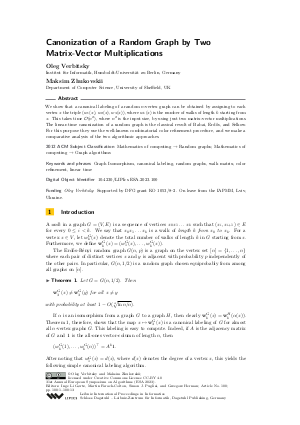Canonization of a Random Graph by Two Matrix-Vector Multiplications
Authors Oleg Verbitsky, Maksim Zhukovskii
-
Part of:
Volume:
31st Annual European Symposium on Algorithms (ESA 2023)
Part of: Series: Leibniz International Proceedings in Informatics (LIPIcs)
Part of: Conference: European Symposium on Algorithms (ESA) - License:
 Creative Commons Attribution 4.0 International license
Creative Commons Attribution 4.0 International license
- Publication Date: 2023-08-30
File

PDF
LIPIcs.ESA.2023.100.pdf
- Filesize: 0.64 MB
- 13 pages
Document Identifiers
Subject Classification
ACM Subject Classification
- Mathematics of computing → Random graphs
- Mathematics of computing → Graph algorithms
Keywords
- Graph Isomorphism
- canonical labeling
- random graphs
- walk matrix
- color refinement
- linear time
Metrics
- Access Statistics
-
Total Accesses (updated on a weekly basis)
0Document
0Metadata
Abstract
We show that a canonical labeling of a random n-vertex graph can be obtained by assigning to each vertex x the triple (w₁(x),w₂(x),w₃(x)), where w_k(x) is the number of walks of length k starting from x. This takes time 𝒪(n²), where n² is the input size, by using just two matrix-vector multiplications. The linear-time canonization of a random graph is the classical result of Babai, Erdős, and Selkow. For this purpose they use the well-known combinatorial color refinement procedure, and we make a comparative analysis of the two algorithmic approaches.
Cite As Get BibTex
Oleg Verbitsky and Maksim Zhukovskii. Canonization of a Random Graph by Two Matrix-Vector Multiplications. In 31st Annual European Symposium on Algorithms (ESA 2023). Leibniz International Proceedings in Informatics (LIPIcs), Volume 274, pp. 100:1-100:13, Schloss Dagstuhl – Leibniz-Zentrum für Informatik (2023)
https://doi.org/10.4230/LIPIcs.ESA.2023.100
BibTex
@InProceedings{verbitsky_et_al:LIPIcs.ESA.2023.100,
author = {Verbitsky, Oleg and Zhukovskii, Maksim},
title = {{Canonization of a Random Graph by Two Matrix-Vector Multiplications}},
booktitle = {31st Annual European Symposium on Algorithms (ESA 2023)},
pages = {100:1--100:13},
series = {Leibniz International Proceedings in Informatics (LIPIcs)},
ISBN = {978-3-95977-295-2},
ISSN = {1868-8969},
year = {2023},
volume = {274},
editor = {G{\o}rtz, Inge Li and Farach-Colton, Martin and Puglisi, Simon J. and Herman, Grzegorz},
publisher = {Schloss Dagstuhl -- Leibniz-Zentrum f{\"u}r Informatik},
address = {Dagstuhl, Germany},
URL = {https://drops.dagstuhl.de/entities/document/10.4230/LIPIcs.ESA.2023.100},
URN = {urn:nbn:de:0030-drops-187536},
doi = {10.4230/LIPIcs.ESA.2023.100},
annote = {Keywords: Graph Isomorphism, canonical labeling, random graphs, walk matrix, color refinement, linear time}
}
Author Details
Funding
- Verbitsky, Oleg: Supported by DFG grant KO 1053/8-2. On leave from the IAPMM, Lviv, Ukraine.
References
-
Noga Alon and Joel H. Spencer. The probabilistic method. John Wiley & Sons, 2016.

-
László Babai, Paul Erdős, and Stanley M. Selkow. Random graph isomorphism. SIAM Journal on Computing, 9(3):628-635, 1980.

- László Babai and Ludek Kucera. Canonical labelling of graphs in linear average time. In 20th Annual Symposium on Foundations of Computer Science (FOCS'79), pages 39-46. IEEE Computer Society, 1979. URL: https://doi.org/10.1109/SFCS.1979.8.
-
Z. Dvořák. On recognizing graphs by numbers of homomorphisms. Journal of Graph Theory, 64(4):330-342, 2010.

- Chris Godsil. Controllable subsets in graphs. Ann. Comb., 16(4):733-744, 2012. URL: https://doi.org/10.1007/s00026-012-0156-3.
- Elias M. Hagos. Some results on graph spectra. Linear Algebra Appl., 356(1-3):103-111, 2002. URL: https://doi.org/10.1016/S0024-3795(02)00324-5.
- David Harvey and Joris van der Hoeven. Integer multiplication in time O(nlog n). Annals of Mathematics, 193(2):563-617, 2021. URL: https://doi.org/10.4007/annals.2021.193.2.4.
- Fenjin Liu and Johannes Siemons. Unlocking the walk matrix of a graph. J. Algebr. Comb., 55(3):663-690, 2022. URL: https://doi.org/10.1007/s10801-021-01065-3.
- H. L. Morgan. The generation of a unique machine description for chemical structures - a technique developed at chemical abstracts service. J. Chem. Doc., 5(2):107-113, 1965. URL: https://doi.org/10.1021/c160017a018.
- Sean O'Rourke and Behrouz Touri. On a conjecture of Godsil concerning controllable random graphs. SIAM J. Control. Optim., 54(6):3347-3378, 2016. URL: https://doi.org/10.1137/15M1049622.
- David L. Powers and Mohammad M. Sulaiman. The walk partition and colorations of a graph. Linear Algebra Appl., 48:145-159, 1982. URL: https://doi.org/10.1016/0024-3795(82)90104-5.
- Sharad S. Sane. The Shrikhande graph. Resonance, 20:903-918, 2015. URL: https://doi.org/10.1007/s12045-015-0255-7.
